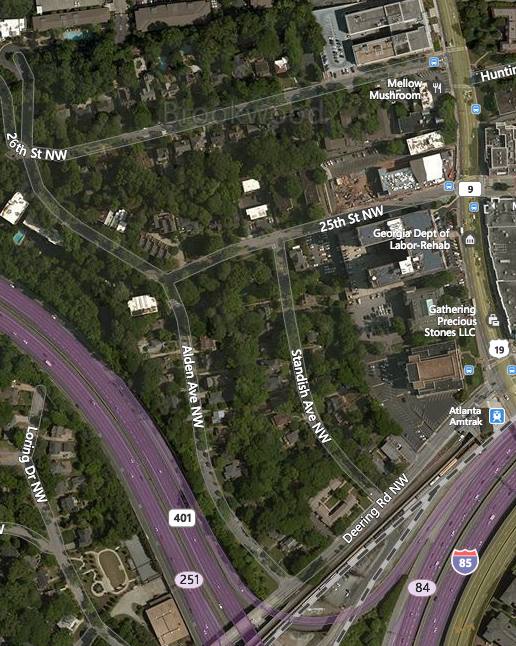History
Dr. Joseph Thompson (September 29, 1797–August 21, 1885) was an early settler of Atlanta, GA; hotelier; and real-estate investor.
Dr. Joseph Thompson
Born to a Pennsylvania-bred family in Spartanburg County, South Carolina, he practiced medicine as a youth. He moved to the new town of Decatur, where he married Mary Ann Tomlinson Young in 1827. He ran a stage coach between the state capital, Milledgeville, and Tuscumbia, Alabama, by way of Decatur, where he kept an inn. He was an important man in town, friend of Judge William Ezzard and John Glen (both future mayors of Atlanta), and was entrusted by the citizenry to make sure that the terminus of the Western & Atlantic Railroad not be their little town. As Terminus (and later Marthasville and still later Atlanta) grew, the Georgia Railroad built a brick hotel building for railroad workers and asked Dr. Thompson to run it.
He and his family arrived in recently-founded Atlanta in 1845. He ran the Atlanta Hotel until its destruction after the Battle of Atlanta. The Atlanta Hotel was the largest and best hotel in town at the time and he was known as a genial host. His witticisms there were often quoted in the Editor’s Drawer feature of Harper’s Magazine. He had many residents there including Atlanta’s first mayor Moses Formwalt (whose estate Thompson later administered) and Alexander Stephens (who was stabbed at the hotel in 1848 by Judge Francis Cone).
The Thompsons’ eldest child, Mary Jane, married Richard Peters in 1848. Mrs. Thompson died at their Atlanta home in 1849 and he remarried in 1851. His second wife died three years later. He married a third time in 1858 and remained with her until her death in 1878.
He owned many important parcels of land in the young city including the future location of the SunTrust Bank building at Five Points. In 1850 he was on the committee that brought the town its first agricultural fair, the Fifth Annual Fair of the Southern Central Agricultural Association, which was held at newly-purchased land at the end of Fair Street (now Memorial Drive).
After the Civil War, he sold $70,000 worth of real estate including the site of his hotel where the Kimball House was later built. In 1867, when General Pope of the Third Military District ordered election committees to oversee changes in voter status, Pope named Dr. Thompson to head the committee for Atlanta.
At the time of his death in 1885, he was president of the Medical College in Atlanta and still resided on Pryor Street.
Our neighborhood was founded in 1922. It was designed by Frederick Law Olmsted, who also designed the Biltmore estate and many other fine areas of Atlanta. Unlike many neighborhoods that are named from a figment of the developer’s imagination, our neighborhood and Brookwood Hills across Peachtree were named after an estate called “Brookwood”. At this time the residential areas of Atlanta extended no further north than 6th Street. Foust Street (now Deering Road) was the city limit.
The Brookwood estate was built in the late 1880s and was the rural retreat, if you can imagine, of Emma and Joseph Thompson, a prominent couple who played an important part in the Cotton States & International Exposition of 1895. This exposition was on the site of what is now Piedmont Park and included a race track as well other venues.
According to respected Atlanta historian, Franklin M. Garrett, the Brookwood estate was located no more than two blocks north of the railroad station, on the same side of the street. There is conjecture that the home sat where the Mellow Mushroom is now located, and further, that it was relocated to 26th Street. The house was the popular Queen Anne style, featuring a wrap-around porch, fish scale shingles and other decorative effects. Below is a photo of the house, seen from the rear, courtesy of the Atlanta Historical Society. Notice the upstairs sleeping porches – no air conditioning at this time.
At one point, the Nunnally Company (the Nunnally Candy Company), which first marketed its boxed “Nunnally’s” chocolates in 1884, owned the area along Peachtree which is now Brookwood. This may account for the number of old pecan trees in the neighborhood. The Nunnally Candy Company was incorporated in 1893 by James H. Nunnally (son of Aaron Dickson Nunnally and A. Ophelia Barrett). His son, Winship Nunnally, joined the company in 1906. They sold the Nunnally's brand to Hollingsworth Candy Co. in 1932. Besides making candy which was sold in drugstores (along with Coca-Cola) around the South, the Nunnally Company also had a soda fountain in Atlanta where they sold their own brand of root beer, among other sodas and frozen treats. The Nunnally Company was later a division of the Fine Products Company Inc. of Augusta, GA, and was eliminated in the fall of 1978 after the company became unprofitable.
There is a rumor that when SunTrust Bank created the lots in Brookwood, one of the ones on Standish was truncated. There was a simple dwelling on it that had belonged to one of the family’s servants. That plot of land was protected so that the children could grow up and finish school in their home. They made their way down the alley each morning to the school bus. In 2007, the Rowe family living at 51 Standish was finally able to restore this section to their lot.
Thompson Residence - photo courtesy of the Atlanta History Center
The Nunnally Company - Atlanta, GA
1919 Nunnally's Candy print advertisement - photo courtesy of WorthPoint
Mrs. Thompson - photo courtesy of the Atlanta History Center


